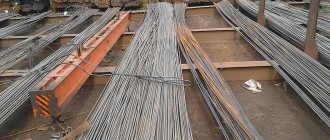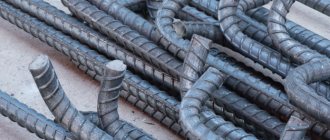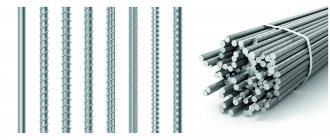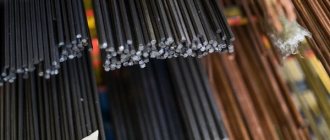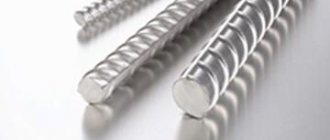Smooth fittings are a more versatile material when compared with similar products with a corrugated profile. But despite the versatility of such reinforcement, it is not recommended to use it in cases where it is necessary to create reinforced concrete structures with increased strength. Today, several types of smooth reinforcement are produced, differing both in manufacturing technology and in their strength class.
Construction reinforcement with smooth surface
Application of smooth profile reinforcement
Steel reinforcement is the main element used to effectively reinforce structures made of concrete. With the help of such metal rods, they enhance the strength of parts of building structures (floors, foundations, columns), individual parts (beams, slabs, elements of staircases), as well as various products made from concrete (pillars, pipes, floor slabs, etc.).
Steel reinforcement with a corrugated profile has the best adhesion properties to concrete, which is why it is used to create structures that are subject to increased demands on their strength, reliability and durability. Meanwhile, the cost of corrugated reinforcement is higher than the price of products with a smooth profile, so the use of the latter in many situations where they are able to provide the required characteristics to concrete structures is more economically feasible.
It is practically impossible to do without smooth reinforcement if concrete products are created for decorative purposes and are lightly loaded during operation. Such products, in particular, include: short pillars and oversized columns, thresholds, floor and wall screeds, building blocks, paving slabs, etc. Using smooth steel reinforcement, masonry joints between bricks and building blocks are also reinforced, which significantly increases their strength and, accordingly, improve the strength characteristics and stability of the walls of the structure being built. With such reinforcement, smooth steel rods can be laid in mortar joints as separate elements or tied into a reinforcing mesh.
The use of bars with a smooth surface as structural elements of the reinforcement skeleton
The versatility of smooth steel reinforcement also lies in the fact that such an element is used not only to improve the strength characteristics of various concrete products, but also to solve a number of other problems. The most common areas of application of this fittings are:
- production of hardware products for construction purposes and for use in other fields of activity: bolts, nuts, studs, etc.;
- use of metal structures for various purposes as elements;
- production of hinges for lifting and installation of concrete and metal structures;
- creation of fences and other enclosing structures made of metal;
- use as elements of a grounding loop.
Gate latches made of smooth reinforcement welded in the letter “G”
Main purpose
Construction mounting fittings are intended for the manufacture of frame products to strengthen concrete used for the construction of objects for various purposes. As a rule, these are periodic profile rods with different diameters.
Volumetric and flat frames are calculated structurally. They are made from individual rods by welding or wire tying.
The need to use reinforcement in reinforced concrete structures is due to the weakness of concrete to bending and compression. Such loads are experienced by floor slabs, wall and foundation blocks, lintels and other structural elements. Without reinforcement, products crack and collapse. The frame solves the problem - rigid reinforcement works in tension and compensates for the destructive stress in the concrete. Moreover, the frames are necessarily located in the lower stretched part, where the maximum deformation force occurs, as well as throughout the entire volume to stabilize and redistribute the load.
Requirements for the characteristics of smooth steel reinforcement
The standard containing the requirements for technical and other characteristics of the most common types of smooth-type fittings is GOST 5781-82. The provisions of this GOST stipulate the requirements for hot-rolled steel products having a circular cross-section and a periodic or smooth profile. The purpose of such steel products, as specified in GOST, is to reinforce conventional as well as pre-stressed structures made from concrete.
State standard 5781-82 divides reinforcing steel into a number of types, depending on the strength, mechanical, and other properties of the material:
- A-I (A240);
- A-II (A300);
- A-III (A400);
- A-IV (A600);
- AV (A800);
- A-VI (A1000).
Grades of steel used for the manufacture of fittings
By the designation of the class of the material, which is visible in parentheses, you can recognize such a characteristic as the yield strength. In general, next to the letter designation it is not the yield strength of steel itself for the production of reinforcement of a certain class, measured in kgf/mm2, but its value increased by 10 times. Thus, for steel of class A1 (A240) the yield strength is 24 kgf/mm2, and for material of class A2 (A300) - 30 kgf/mm2.
According to GOST 5781-82, only class A1 fittings are produced with a smooth profile, and products of all other categories are produced with a periodic profile. Meanwhile, GOST also stipulates the possibility of producing steel reinforcement of classes A2–A5 with a smooth profile, if the customer so desires.
Reinforcement profile drawing
Maximum deviations in dimensions of reinforcing steel (click to enlarge)
Among consumers of reinforcing products, the most popular are fittings belonging to class A-I. It is available only with a smooth type profile. It is for this reason that the provisions of GOST provide for the production of reinforcement of all other classes, mainly with a periodic profile.
The high popularity of class A1 reinforcement is due to the fact that only mechanical properties, as well as other characteristics of the material used for its manufacture, make it possible to take advantage of all the advantages provided by a smooth profile. Carbon steel grades St3sp, St3ps and St3kp, from which hot-rolled reinforcement products of class A-I are made, make such a product truly universal. This steel reinforcement bends well, welds well and is easily amenable to other processing methods.
In accordance with GOST 5781-82, reinforcing products of other classes are made from carbon steel with higher strength characteristics or from low-alloy steel alloys. Thus, the materials for obtaining reinforcement of various types are:
- A-II - St5sp, St5ps, 10GT, 1Ng2S;
- A-III - 25G2S, 35GS, 32G2Rps;
- A-IV - 20ХГ2Ц, 80С;
- AV - 23Kh2G2T, 22Kh2G2R, 22Kh2G2AYU, 20Kh2G2SR.
If the chemical composition of low-alloy steels used for the production of reinforcing products is stipulated by the provisions of GOST 5781-82, then for carbon steels the norms of another standard apply: 380.
Chemical composition of low alloy steels
Range of smooth type reinforcement products
GOST 5781-81 stipulates not only the technical and other characteristics of smooth profile reinforcement products, but also their range, which includes 20 standard sizes of such reinforcement. Thus, the provisions of GOST provide for the production of smooth reinforcement of the following diameters: 6, 8, 10, 12, 14, 16 mm, as well as 18, 20, 22, 25, 28, 32, 36, 40, 45, 50, 55, 60, 70 and 80 mm. The cross-sectional area of the reinforcement of each standard size and its specific gravity (theoretical) can also be found out from the provisions of GOST 5781-82. For example, the theoretical weight of reinforcement with a diameter of 16 mm is 1.58 kg, and a product with a diameter of 80 mm is 39.46 kg.
Weight per linear meter of smooth reinforcement
The standard also stipulates the rules for the designation of reinforcing products, as examples of which we can consider the marking of the following elements: 16-AI (A240) GOST 5781-82 - reinforcing bar with a diameter of 16 mm, corresponding to class AI; 22-A-IV (A600) GOST 5781-82 is a reinforcing bar of class A-IV, the diameter of which is 22 mm.
In the table, which presents the entire range of smooth fittings, you can find out all the sizes corresponding to each class of products, as well as their technical characteristics.
Mechanical properties of reinforcing steel
The deviations that smooth reinforcement may have in its nominal diameter are stipulated by the provisions of standard 2590. All hot-rolled round sections, the diameter of which is in the range of 5–270 mm, must comply with its requirements. The standard also stipulates such a parameter of round reinforcing bars as their ovality, which is calculated as follows: the difference between the largest and smallest values of the actual profile diameters measured in one section is taken. Such a difference, according to GOST requirements, should not be greater than the sum of the tolerances (plus and minus) specified for a given diameter.
Manufacturers produce reinforcing steel belonging to different classes, as well as different diameters, in the following form:
- reinforcement belonging to classes AI and A-II, with a transverse size of up to 12 mm, is allowed to be supplied to customers in rods or coils, and if its diameter is larger - only in rods;
- products belonging to class A-III with a cross-sectional size of up to 10 mm are allowed to be supplied in coils or in the form of rods, if the diameter is larger - in rods;
- reinforcement of classes A-IV and AV is supplied mainly in rods, with the exception of products with a transverse size of 6 and 8 mm; by prior agreement with the customer, such products can be supplied in the form of coils.
Reinforcement brand A1 with a diameter of 10 mm, supplied in coils
The length of the reinforcement bars, which can be in the range of 6–12 m, must also meet certain requirements. Thus, rods can be supplied to the customer in measured and unmeasured lengths; batches of measured length are also allowed, which contain no more than 15% of unmeasured rods, the length of which is not less than 2 meters. The regulatory document allows that, by prior agreement with the customer, bars of smooth reinforcement can be cut to lengths in the range of 5–25 m.
For the length of measured products, which can correspond to normal or increased accuracy, the standard stipulates the following tolerances:
- reinforcing bars, the length of which does not exceed 6 m: normal accuracy - +50 mm, cutting with increased accuracy - +25 mm;
- products longer than 6 meters: normal accuracy - +70 mm, increased accuracy - +35 mm.
The curvature of steel reinforcing bars is also specified by the standard; this parameter should not be more than 0.6% of their length. Smooth reinforcing bars made of AIA-IV steel are not subjected to subsequent heat treatment, and for AV class products, manufacturers perform low-temperature tempering. Such heat treatment in accordance with GOST can be omitted if, after testing, which must be carried out within 12 hours after the products are released, the relative elongation of the reinforcement is at least 9%, and the uniform elongation is at least 2%.
Permissible curvature of rolled steel bars for the production of smooth reinforcement
Storage and transportation
According to GOST, objects of class A240 should be stored and transported in packaged form. The maximum weight of one packaged block with rods should be no more than 15 tons. Packaging is carried out by tying individual rods together. Strong anti-corrosion wire should be used as fastening and should be fastened to each other in at least 4 places. The minimum distance between fastenings is 20 centimeters.
If the diameter of the reinforcement is less than 10 millimeters, then individual spare parts can be transported in coils. The maximum weight of one skein is 1.5 tons. Each package must be marked with an identifying mark. Mandatory information - class/category of reinforcing steel, batch number, technical control mark, date of manufacture, name of the manufacturing plant. By agreement with the customer, some other information may be indicated on the packaging - product code, section diameter, length, batch weight, weight of an individual rod, and others.
Any type of transport can be used to transport the A240 - road, rail, air, sea, river. Delivery must be carried out in batches, where one batch includes bars of the same type. Transportation of various products is allowed if additional appropriate markings are applied to them. When handing over the goods, it is necessary to hand over to the new owner not only the rods themselves, but also the accompanying documentation. The payment method is determined based on the agreement between the buyer and the seller (prepayment, payment upon receipt, payment after receipt of the goods based on the contract).
Mechanical properties of reinforcement
GOST for smooth profile reinforcement, as discussed above, stipulates various technical characteristics and mechanical properties of products. All of these characteristics and properties can be found by studying the corresponding tables, but for information we will consider some of them.
For such parameters of smooth reinforcement as tensile strength, minimum relative and uniform elongation, the standard specifies the following requirements:
- AI: 373 N/mm2 (38 kgf/mm2); 25%; the indicator is not standardized;
- A-II: 490 N/mm2 (50 kgf/mm2); 19%; non-standardized indicator;
- A-III: 590 N/mm2 (60 kgf/mm2); 14%; non-standardized indicator;
- A-IV: 883 N/mm2 (90 kgf/mm2); 6%; 2%;
- AV: 1030 N/mm2 (105 kgf/mm2); 7%; 2%.
Mechanical properties of reinforcement class A (click to enlarge)
Smooth steel reinforcement is subjected to bending tests, and mandrels with different parameters are used for each class:
- AI: mandrel diameter - c, equal to the diameter of the tested reinforcement - d, the product is bent at an angle of 1800;
- A-II: c=3d; bending of reinforcement is also performed at 1800;
- A-III: c=3d; bending is performed at 900;
- A-IV: c=5d; bending is performed at 450;
- AV: c=5d; bending is also performed at 450.
Bending test parameters for reinforcement of different diameters also differ. Thus, for products of class AI (the transverse dimension exceeds 20 mm), bending is performed on a mandrel whose diameter is 2d; for elements of class A-II (diameter also exceeds 20 mm), a mandrel with a diameter equal to 4d is used. The indicators obtained during such tests must have a value of no less than 0.95 of the values specified in GOST 5781-82.
Minimum bending radius of reinforcing bars
GOST also stipulates the condition of the surface of reinforcing bars, which should not contain rolling cracks and damage resulting from stress, the so-called rolled caps, flaws and sunsets. Individual fingerprints, rolled out deposits, dirt, small areas of corrosion, scaliness and rippling on the surface of the rods may still be present. The quality and ease of weldability of reinforcing bars will depend entirely on the chemical composition of the steel, as well as on the technology of their manufacture.
How to determine weight
The weighing procedure may not always be available (for example, in the case of a large structure, weighing may not be possible for purely technical reasons). Therefore, indirect calculation methods are used in practice to determine weight. In production, reinforcing bars are often cut into separate identical fragments, and reference information about the total weight of the package and the weight of one object is applied to the packaging of the products.
If you have a sticker with all the necessary information, then determining the total weight will be easy:
- Use the sticker on the package to find out the weight of one spare part.
- Count the number of rods you used to create the structure.
- Multiply the number of rods by the weight of one product - you will get the total weight.
Determining weight using formula
If the sticker is lost, you can approximately determine the weight based on the length and thickness of the rods. This is done using a special formula: M = 3.14 x P x D x D x h. The formula is deciphered as follows:
- 3.14 is a correction factor that is equal to the mathematical constant Pi. The coefficient appears in the formula due to the fact that the reinforcement according to GOST has a round cross section.
- P is the density of the steel alloy. This value is variable and depends on the composition of the alloy. The density of most steel alloys ranges from 7700 to 8000 kg per 1 cubic meter. Therefore, for the convenience of calculations, the parameter P is equated to the average value, which is 7850 kg per cubic meter.
- D is the cross-sectional diameter of the rod. The parameter must be expressed in meters. If you know the value of the diameter in millimeters, then you need to divide this number by 1000. Also note that according to the formula, diameter appears twice (that is, this number needs to be multiplied 2 times).
- h is the length of the metal rod. This parameter must also be expressed in meters. If you know the value in millimeters, then the parameter must be divided by 1000; if you know the value in centimeters - by 100.
For convenience, let's look at a few examples. For convenience, we equate the parameter P (density) to the average value of 7850:
- Let us have 8 mm reinforcement; the total length of the structure is 10 meters. Let's determine the weight: M = 3.14 x P x D x D xh = 3.14 x 7850 x 0.008 x 0.008 x 10 = 15.8 kg.
- Let us have 16 mm reinforcement, the length of which is 20 meters. Let's determine its weight: M = 3.14 x P x D x D xh = 3.14 x 7850 x 0.016 x 0.016 x 20 = 126.2 kg.
Other regulatory documents
Steel reinforcement products with a smooth profile, which are additionally hardened by thermomechanical methods, are produced in accordance with GOST 10884-94. The requirements of this regulatory document apply to products with a transverse size of 6–40 mm used for reinforcing concrete structures.
Strengthened steel reinforcement is also represented by several classes into which it is divided, depending on the following parameters.
- Mechanical properties of reinforcement. This parameter means a strength class, which is determined by the conditional or actual (physical) yield strength, measured in N/mm2.
- Performance characteristics. According to this parameter, the reinforcement is classified as weldable (C) and characterized by increased resistance to factors such as corrosion cracking (K).
So, depending on the above parameters, reinforced smooth type reinforcement is represented by the following classes: At400S, At500S, At600, At600S, At600K, At800, At800K, At1000, At1000K, At1200.
Color marking of reinforcing bars
According to standard 10884-94, products with a periodic profile are mainly produced. The only exceptions may be products of class At800 and with a higher level of strength, which, by agreement between the manufacturer and the customer, can be manufactured with a smooth profile. If reinforced reinforcement is produced with a smooth profile, then its important technical parameters: weight, cross-sectional area, tolerances for deviations in mass and geometric parameters, curvature, ovality of products, etc. must fit within the requirements of GOST 5781-82.
The following diameters of manufactured products correspond to different classes of smooth reinforced reinforcement:
- At800 - 10–32 mm;
- At800K - 18–32 mm;
- At1000, At1000K - 10–32 mm;
- At1200 - 10–32 mm.
The length of the bars of smooth reinforced reinforcement, which is specified at the stage of placing an order, can be measured (5.5–13.5 m) and permissibly measured (length up to 26 m). Permissible deviations in the length of rods of such reinforcement must also comply with the requirements of standard 5781-82.
The rules for marking smooth reinforcement belonging to the reinforced type are no different from the procedure for marking elements that belong to the regular category.
Marking reinforcement using marks on bars
Technical requirements for reinforced type reinforcement
Reinforced reinforcement products are made exclusively from low-alloy steels:
- At800: 08G2S, 10GS2, 20GS, 20GS2, etc.;
- At800K: 25S2R, 35GS;
- At1000: 20GS, 20GS2, 25S2R;
- At1000K: 20HGS2;
- At1200: 30ХС2.
Strengthened smooth type reinforcement in terms of parameters such as tensile strength (N/mm2), yield strength (N/mm2), relative and uniform elongation (%) must correspond to the following values:
- At800: 1000; 800; 8; 2;
- At1000: 1250; 1000; 7; 2;
- At1200: 1450; 1200; 6; 2.
Smooth reinforcement of these types is also checked for bending, for which a mandrel with a diameter of 5d is used, and the product itself is bent at an angle of 450.
A very important requirement for reinforced reinforcement, manufactured with a smooth profile, is that such products should not collapse even after 2 million cycles of stress applied to them, the value of which should be at least 70% of the value of the ultimate tensile strength (nominal) , which corresponds to the material of the rod.
